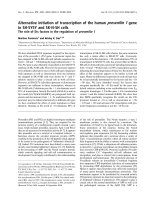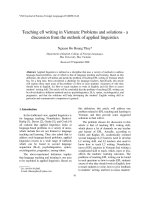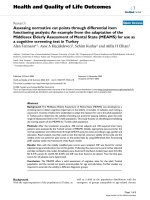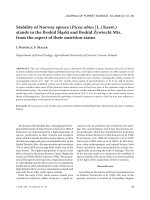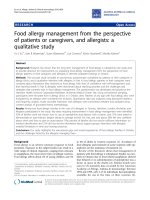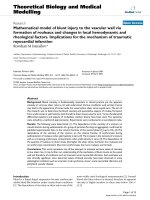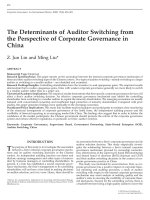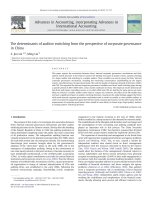Intangible Values in Financial Accounting and Reporting An Analysis from the Perspective of Financial Analysts
Bạn đang xem bản rút gọn của tài liệu. Xem và tải ngay bản đầy đủ của tài liệu tại đây (26.17 MB, 564 trang )
Intangible Values in Financial Accounting and Reporting
An Analysis from the Perspective of Financial Analysts
DISSERTATION
of the University of St. Gallen,
School of Management,
Economics, Law, Social Sciences
and International Affairs
to obtain the title of
Doctor of Philosophy in Management
submitted by
Stephan Grüber
from
Germany
Approved on the application of
Prof. Dr. Peter Leibfried
and
Prof. Dr. Dirk Schäfer
Dissertation no. 4274
Springer Gabler, Wiesbaden 2014
The University of St. Gallen, School of Management, Economics, Law, Social
Sciences and International Affairs hereby consents to the printing of the present
dissertation, without hereby expressing any opinion on the views herein expressed.
St. Gallen, May 19, 2014
The President:
Prof. Dr. Thomas Bieger
Intangible Values in Financial
Accounting and Reporting
Stephan Grüber
Intangible Values in
Financial Accounting
and Reporting
An Analysis from the Perspective
of Financial Analysts
With a Foreword by Prof. Dr. Peter Leibfried
Stephan Grüber
St. Gallen, Switzerland
Dissertation, University of St. Gallen, Switzerland
ISBN 978-3-658-06549-2
DOI 10.1007/978-3-658-06550-8
ISBN 978-3-658-06550-8 (eBook)
The Deutsche Nationalbibliothek lists this publication in the Deutsche Nationalbibliografie;
detailed bibliographic data are available in the Internet at .
Library of Congress Control Number: 2014944657
Springer Gabler
© Springer Fachmedien Wiesbaden 2015
This work is subject to copyright. All rights are reserved by the Publisher, whether the whole
or part of the material is concerned, specifically the rights of translation, reprinting, reuse of
illustrations, recitation, broadcasting, reproduction on microfilms or in any other physical
way, and transmission or information storage and retrieval, electronic adaptation, computer software, or by similar or dissimilar methodology now known or hereafter developed.
Exempted from this legal reservation are brief excerpts in connection with reviews or scholarly analysis or material supplied specifically for the purpose of being entered and executed
on a computer system, for exclusive use by the purchaser of the work. Duplication of this
publication or parts thereof is permitted only under the provisions of the Copyright Law of
the Publisher’s location, in its current version, and permission for use must always be obtained
from Springer. Permissions for use may be obtained through RightsLink at the Copyright
Clearance Center. Violations are liable to prosecution under the respective Copyright Law.
The use of general descriptive names, registered names, trademarks, service marks, etc. in this
publication does not imply, even in the absence of a specific statement, that such names are
exempt from the relevant protective laws and regulations and therefore free for general use.
While the advice and information in this book are believed to be true and accurate at the date
of publication, neither the authors nor the editors nor the publisher can accept any legal responsibility for any errors or omissions that may be made. The publisher makes no warranty,
express or implied, with respect to the material contained herein.
Printed on acid-free paper
Springer Gabler is a brand of Springer DE.
Springer DE is part of Springer Science+Business Media.
www.springer-gabler.de
Foreword
V
FOREWORD
Even though intangible values have continuously become significant value drivers of
companies in today’s economy, financial accounting and reporting still lacks to
properly incorporate and to report such values. Despite the ongoing debate throughout
the past decades, a universal solution inside or outside of the traditional information
means has not yet been developed. As a consequence, financial accounting and
reporting still provides an incomplete picture of an entity’s true resources and claims.
While it is necessary to acknowledge that financial accounting and reporting has
inherent limitations and is not supposed to present absolute data, further analysis is
required to better understand and to potentially close the information gap. In this
thesis, Stephan Grüber focuses on the information use of financial analysts, one of the
primary users of IFRSs. He investigates how financial analysts utilize and incorporate
information on intangible values in their decision-making processes and whether such
information influences decisions. In addition, the study examines the preferences of
financial analysts in regard to accounting for and reporting intangibles in the future.
Upon outlining the fundamentals of financial accounting and reporting, Stephan
examines the foundations and challenges of intangible values and provides an
overview of concepts introduced to improve the accounting and reporting of
intangibles. As a next step, he distinguishes various groups of financial analysts and
their decision-making objectives, such as buy- and sell-side analysts and equity and
fixed income analysts. Chapter 5 represents the main body of this thesis, presenting
and discussing two empirical studies. The first part describes the results of a content
analysis of sell-side research reports, offering insights into the information use of sellside analysts. The second part analyzes the results of a web-based experimental survey
with over 1,100 financial analysts, focusing on the importance of information of
intangibles for their decision-making.
The present analysis offers detailed and comprehensive evidence on the actual
information use and preferences of financial analysts, contributing to an improved
understanding of the user perspective in financial accounting and reporting, i.e. what
users effectively require with respect to information on intangible values. Hence, this
thesis may not only be valuable to individuals in academia, but is also useful for
VI
Foreword
practitioners and executives focusing on corporate communication. In addition, the
results may further provide financial analysts with stimulating self-insight regarding
their decision-making. I therefore wish this thesis to be widely read and accepted by a
broad audience.
St. Gallen, June 2014
Prof. Dr. Peter Leibfried, CPA, MBA
Managing Director of the Institute of Accounting, Control and Auditing (ACA-HSG)
at the University of St.Gallen and doctoral advisor of Stephan Grüber
Acknowledgements
VII
ACKNOWLEDGEMENTS
The present thesis is the result of my Ph.D. studies at the University of St. Gallen
(HSG) in Switzerland. It was submitted and approved to obtain the title Doctor of
Philosophy in Management.
Throughout the course of my studies, there has been much support from many
different people and I would like to take this opportunity to thank all of them. First and
foremost, I am particularly indebted to my doctoral advisor, Prof. Dr. Peter Leibfried,
who made this research possible, continuously providing me with guidance and
encouragement over many years. His insights and advice significantly helped me to
complete this work. I would further like to express my sincere gratitude to Prof. Dr.
Dirk Schäfer, who served as co-advisor and supported this project with valuable
thoughts and ideas.
I have written this thesis while being a full-time employee at KPMG LLP in New
York. In order to participate in the Ph.D. program in St. Gallen and to draft my thesis I
was granted several study leaves. I would therefore like to express my genuine thanks
to Dr. Norbert Fischer and Jan Storbeck for their trust and flexibility. Moreover, I also
thank Ingo Zielhoff, who supported me during the final phase of this project.
I would also like to specifically thank Dr. Torsten Jaskolski for discussing and
exchanging our ideas throughout the years. Special thanks go to Nicholas Jungovic for
supporting me and reading the draft of this thesis. In addition, I further extend my
thanks to my family and friends, who have always been there for me despite my
limited time.
My deepest gratitude goes to my love Sophie for her unbounded patience,
understanding and sacrifices along the way, as well as for her motivating and
encouraging words during difficult times. Last but not least, I would also like to extend
my appreciation and thanks to my parents for their love and unconditional support.
This thesis is dedicated to them – it would not have been possible without them.
Zurich, June 2014
Stephan Grüber
Brief Contents
IX
BRIEF CONTENTS
1.
INTRODUCTION .....................................................................................................1
1.1. Relevance and Motivation of this Study ..........................................................1
1.2. Purpose and Methodology of this Study ..........................................................3
2.
THE FUNDAMENTALS OF FINANCIAL ACCOUNTING AND REPORTING .................7
2.1. Introduction to the Chapter .............................................................................7
2.2. Justification for the Existence of Financial Accounting and Reporting............7
2.3. Principles of Capital Markets-Oriented Financial Accounting and
Reporting .....................................................................................................24
2.4. Preliminary Summary ...................................................................................33
3.
FOUNDATION AND CHALLENGES OF INTANGIBLE VALUES IN FINANCIAL
ACCOUNTING AND REPORTING ..........................................................................35
3.1. Introduction to the Chapter ...........................................................................35
3.2. Characteristics and Attributes of Intangibles .................................................35
3.3. Intangibles and International Financial Reporting Standards .........................52
3.4. Concepts to Improve Financial Accounting and Reporting of Intangible
Values ..........................................................................................................82
3.5. Consequences for the Further Analysis ....................................................... 108
4.
FINANCIAL ANALYSTS AS USERS OF FINANCIAL ACCOUNTING AND
REPORTING INFORMATION............................................................................... 110
4.1. Introduction to the Chapter ......................................................................... 110
4.2. Fundamentals of Financial Analysts ........................................................... 111
4.3. The Elements of Financial Analysts’ Decision-Making .............................. 131
4.4. Financial Analysts and Information on Intangible Values ........................... 145
4.5. Summary and Implications for this Study ................................................... 163
5.
EMPIRICAL ANALYSES OF THE PERSPECTIVE OF FINANCIAL ANALYSTS ON
INFORMATION ABOUT INTANGIBLES ................................................................ 166
5.1. Introduction to the Chapter ......................................................................... 166
5.2. Content-Analysis of Sell-Side Research Reports......................................... 169
5.3. Experimental Survey .................................................................................. 274
5.4. Limitations of the Selected Methodologies ................................................. 399
X
Brief Contents
6.
SUMMARY AND CONSEQUENCES FOR REPORTING INTANGIBLE VALUES ........ 401
6.1. Introduction to the Chapter ......................................................................... 401
6.2. Summary and Implications of the Findings ................................................. 401
6.3. Recommendations for Accounting and Reporting Intangible Values........... 408
6.4. Future Prospects ......................................................................................... 411
Table of Contents
XI
TABLE OF CONTENTS
FOREWORD ................................................................................................................. V
ACKNOWLEDGEMENTS ............................................................................................ VII
BRIEF CONTENTS ...................................................................................................... IX
TABLE OF CONTENTS ................................................................................................ XI
ABSTRACT ............................................................................................................. XVII
LIST OF ABBREVIATIONS ....................................................................................... XIX
LIST OF FIGURES................................................................................................... XXV
LIST OF TABLES ...................................................................................................XXIX
1.
2.
INTRODUCTION .....................................................................................................1
1.1.
Relevance and Motivation of this Study ......................................................1
1.2.
Purpose and Methodology of this Study ......................................................3
THE FUNDAMENTALS OF FINANCIAL ACCOUNTING AND REPORTING .................7
2.1.
Introduction to the Chapter .........................................................................7
2.2. Justification for the Existence of Financial Accounting and Reporting .....7
2.2.1. Neoclassical Economic and Finance Theory ...............................................8
2.2.1.1.
The Efficient-Market Hypothesis and Empirical Evidence................9
2.2.1.2.
Implications of the Efficient-Market Hypothesis ............................11
2.2.2. New Institutional Economics and Principal Agent Theory ........................14
2.2.2.1.
Information Asymmetries and Agency Costs ..................................16
2.2.2.2.
Financial Information as a Solution to the Agency Problem............18
2.2.3. Summary and Consequences for the Design of Financial Accounting
and Reporting ...........................................................................................21
2.3.
Principles of Capital Markets-Oriented Financial Accounting and
Reporting ....................................................................................................24
2.3.1. Primary User Group and Objectives of International Financial
Reporting Standards ..................................................................................24
2.3.2. Definition and Criteria of Decision-Useful Information ............................28
2.4.
Preliminary Summary ................................................................................33
XII
3.
Table of Contents
FOUNDATION AND CHALLENGES OF INTANGIBLE VALUES IN FINANCIAL
ACCOUNTING AND REPORTING ..........................................................................35
3.1.
Introduction to the Chapter .......................................................................35
3.2. Characteristics and Attributes of Intangibles ...........................................35
3.2.1. Definition and Distinction of Intangibles ..................................................36
3.2.2. Economic Properties of Intangible Values ................................................40
3.2.3. Classification of Intangible Values ...........................................................45
3.2.3.1.
Legal Classification Scheme ...........................................................45
3.2.3.2.
Economic Classification Schemes ..................................................47
3.3. Intangibles and International Financial Reporting Standards ................52
3.3.1. Initial Recognition and Measurement of Intangible Assets ........................53
3.3.1.1.
Definition of Intangible Assets .......................................................55
3.3.1.2.
Recognition and Measurement of Intangible Assets ........................63
3.3.1.3.
Acquisition as Part of a Business Combination ...............................65
3.3.1.4.
Additional Requirements for Internally Generated Intangibles........68
3.3.2. Subsequent Measurement .........................................................................72
3.3.3. Current Disclosure Requirements for Intangible Assets ............................73
3.3.4. Constraints and their Impact .....................................................................74
3.3.4.1.
Decreasing Relevance of IFRSs and It Reasons ..............................74
3.3.4.2.
Impact of Failing to Provide Information on Intangible Values .......77
3.4.
Concepts to Improve Financial Accounting and Reporting of
Intangible Values ........................................................................................82
3.4.1. Extended Reporting within the Classic Presentation Formats ....................82
3.4.1.1.
The AASB Discussion Paper ..........................................................83
3.4.1.2.
Additional Proposals ......................................................................87
3.4.2. Proposals for an Extended Business Reporting of Intangible Values .........89
3.4.2.1.
Top-Down Methods of an Extended Business Reporting ................93
3.4.2.2.
Bottom-Up Methods of an Extended Business Reporting ............. 100
3.5.
4.
Consequences for the Further Analysis ................................................... 108
FINANCIAL ANALYSTS AS USERS OF FINANCIAL ACCOUNTING AND
REPORTING INFORMATION............................................................................... 110
4.1.
Introduction to the Chapter ..................................................................... 110
4.2. Fundamentals of Financial Analysts ........................................................ 111
4.2.1. Definition and Responsibilities of Financial Analysts ............................. 111
4.2.2. Classification and Different Types of Financial Analysts ........................ 115
4.2.2.1.
Institutional Classification ............................................................ 115
4.2.2.2.
Functional Classification .............................................................. 120
Table of Contents
XIII
4.2.3. Financial Analysts as Providers of Useful Information............................ 126
4.3. The Elements of Financial Analysts’ Decision-Making .......................... 131
4.3.1. Collecting Information ............................................................................ 132
4.3.2. Information Processing ........................................................................... 136
4.3.2.1.
Equity Financial Analysts ............................................................. 137
4.3.2.2.
Fixed Income Financial Analysts .................................................. 140
4.3.3. Distribution of Information ..................................................................... 144
4.4. Financial Analysts and Information on Intangible Values ..................... 145
4.4.1. Methods Employed by Equity Analysts .................................................. 145
4.4.1.1.
Technical Analysis ....................................................................... 146
4.4.1.2.
Fundamental Analysis .................................................................. 147
4.4.1.3.
Additional Valuation Models ........................................................ 155
4.4.2. Methods Employed by Fixed Income Analysts ....................................... 156
4.4.3. Behavioral Aspects ................................................................................. 159
4.4.3.1.
Decision-Making Concepts ........................................................... 159
4.4.3.2.
Behavioral Influences ................................................................... 160
4.4.4. Other Aspects ......................................................................................... 163
4.5.
5.
Summary and Implications for this Study............................................... 163
EMPIRICAL ANALYSES OF THE PERSPECTIVE OF FINANCIAL ANALYSTS ON
INFORMATION ABOUT INTANGIBLES ................................................................ 166
5.1.
Introduction to the Chapter ..................................................................... 166
5.2. Content-Analysis of Sell-Side Research Reports ..................................... 169
5.2.1. Purpose of this Content Analysis ............................................................ 169
5.2.2. General Objectives and Methodology of Content Analysis ..................... 170
5.2.3. Prior Content Analyses in Accounting Research ..................................... 174
5.2.4. Research Gap and Hypotheses for this Study .......................................... 184
5.2.5. Research Design of this Study ................................................................ 191
5.2.5.1.
Description of the Research Object ............................................... 191
5.2.5.2.
Sample Selection and Data Collection .......................................... 195
5.2.5.3.
Test Procedures and Constructing the Intangible Score ................. 196
5.2.5.4.
Applied Statistical Tests ............................................................... 203
5.2.6. Validity and Reliability of the Content Analysis ..................................... 209
5.2.7. Findings and Discussion ......................................................................... 213
5.2.7.1.
Descriptive Statistics of the Sample .............................................. 214
5.2.7.2.
Preferred Valuation Methods ........................................................ 219
5.2.7.3.
Results for the Total Sample ......................................................... 221
5.2.7.3.1. Human Capital Information Items .............................................. 225
XIV
Table of Contents
5.2.7.3.2. Internal Capital Information Items ............................................. 231
5.2.7.3.3. External Capital Information Items ............................................ 241
5.2.7.4.
Results for the Hypotheses Tests .................................................. 246
5.2.7.4.1. Report Characteristics ................................................................ 246
5.2.7.4.2. Firm Characteristics ................................................................... 253
5.2.8. Preliminary Summary ............................................................................. 271
5.3. Experimental Survey ................................................................................ 274
5.3.1. Objectives of the Survey ......................................................................... 274
5.3.2. Sample and Data Collection Procedures .................................................. 276
5.3.3. Survey Structure and Applied Statistical Tests ........................................ 279
5.3.3.1.
Investment Recommendation Task ............................................... 280
5.3.3.1.1. The General Framework of Conjoint Analysis ........................... 281
5.3.3.1.2. Conjoint Analysis in Accounting and Finance Research............. 295
5.3.3.1.3. Design of the Investment Recommendation Task ....................... 304
5.3.3.2.
Design and Approach Related to Other Investigated Variables ..... 311
5.3.4. Response Rate and External Validity ...................................................... 313
5.3.5. Findings and Discussion ......................................................................... 320
5.3.5.1.
Descriptive Statistics of Respondents ........................................... 321
5.3.5.2.
Preferred Information Sources ...................................................... 326
5.3.5.2.1. Results for the Total Sample ...................................................... 327
5.3.5.2.2. Comparisons of Analyst Groups................................................. 330
5.3.5.2.3. Additional Information Sources Mentioned by Financial
Analysts ..................................................................................... 336
5.3.5.3.
Valuation Methods of Financial Analysts ..................................... 337
5.3.5.3.1. Results for the Total Sample ...................................................... 338
5.3.5.3.2. Comparisons of Analyst Groups................................................. 340
5.3.5.3.3. Additional Valuation Methods Mentioned by Analysts .............. 343
5.3.5.4.
Perceived Importance of Inputs for Company Valuation and
Analysis ....................................................................................... 345
5.3.5.4.1. Results for the Total Sample ...................................................... 346
5.3.5.4.2. Comparisons of Analyst Groups................................................. 351
5.3.5.4.3. Additional Valuation Inputs Mentioned by Financial Analysts ... 358
5.3.5.5.
Investment Recommendation Task ............................................... 360
5.3.5.5.1. Results for the Total Sample ...................................................... 361
5.3.5.5.2. Comparison of Different Analyst Groups ................................... 372
5.3.5.6.
Preferences about Reporting Information on Intangibles............... 378
5.3.5.6.1. Results for the Total Sample ...................................................... 379
5.3.5.6.2. Comparison of Analyst Groups .................................................. 385
5.3.5.6.3. Additional Comments Mentioned by Financial Analysts ............ 394
Table of Contents
XV
5.3.6. Preliminary Summary ............................................................................. 397
5.4.
6.
Limitations of the Selected Methodologies .............................................. 399
SUMMARY AND CONSEQUENCES FOR REPORTING INTANGIBLE VALUES ........ 401
6.1.
Introduction to the Chapter ..................................................................... 401
6.2.
Summary and Implications of the Findings ............................................ 401
6.3.
Recommendations for Accounting and Reporting Intangible Values .... 408
6.4.
Future Prospects ....................................................................................... 411
APPENDIX ................................................................................................................. 415
INDEX OF ACCOUNTING PRINCIPLES, STANDARDS AND OTHER STATUTES ............ 485
INDEX OF SELL-SIDE RESEARCH REPORTS CITED IN THE MAIN TEXT ................... 487
REFERENCES ............................................................................................................ 491
Abstract
XVII
ABSTRACT
Many academics and practitioners argue that intangible values have become a
significant value driver of companies in today’s economy. Major production inputs do
no longer comprise of items, such as property, plant and equipment, but rather of
brands, knowledge and other technological innovation. Based on this notion,
information on such phenomena is supposedly crucial for the existing and potential
capital providers in making their decision whether to allocate resources to a company.
The present thesis examines the information use and needs of financial analysts with
respect to intangible values. The purpose is to shed light on the usefulness of such
information from the perspective of one of the primary user groups of IFRSs. This
thesis provides evidence about whether information on such values is actually used in
the decisions of financial analysts and if so, under what circumstances they employ
such information and what type of information they consider as useful.
Upon defining and characterizing intangible values, the current state of IFRSs with
respect to such values is discussed, highlighting the associated issues, the impacts and
the proposals to overcome the current state. Subsequently, the fundamentals of
financial analysts are introduced, including their objectives, their potential
classification schemes as well as their decision-making processes.
The main part of this thesis reports on two empirical studies that were carried out to
examine the actual information use of financial analysts. The first study applied the
method of content analysis to sell-side research reports, finding evidence for the use of
information on intangible values by sell-side analysts. The second study employed
survey methodology to investigate the perceptions of four different analysts groups on
intangible values. The second study further included an experimental part that allowed
observing data derived from actual decisions.
In summary, it was found that information on intangible values is useful for the
decisions of the different analyst groups. Moreover, the user needs and preferences
were discussed in order to define several recommendations of how to report
information on intangible values.
XVIII
Abstract
ZUSAMMENFASSUNG
In den letzten Jahren wurde immer wieder vorgebracht, dass immaterielle Werte
zunehmend die bedeutenden Werttreiber in den Unternehmen der heutigen Zeit
darstellen. Wichtige Produktionsfaktoren sind nicht mehr materielle Vermögenswerte,
sondern vielmehr Marken, Wissen oder anderweitige technologische Innovationen.
Basierend auf dieser Annahme, wird die Aussage getroffen, dass die Informationen
über solche Phänomene in den Allokationsentscheidungen der Kapitalgeber einer
Unternehmung unerlässlich sind.
Die vorliegende Arbeit untersucht die Informationsverwendung durch Finanzanalysten
und deren Informationsbedürfnisse in Bezug auf immaterielle Werte. Zweck der
Arbeit ist es, den Nutzen solcher Informationen aus der Perspektive von einer der
primären Adressatengruppe von IFRS näher zu beleuchten.
Nach der Begriffsabgrenzung des immateriellen Werts, werden zunächst die aktuellen
Regelungen der IFRS dargestellt sowie
problematisiert und die in der Literatur
diskutierten Lösungsvorschläge präsentiert. Im Anschluss werden die Grundlagen der
Finanzanalysten in Bezug zu ihren Zielen, möglichen Klassifizierungen und
Entscheidungsprozessen dargestellt.
Im Hauptteil dieser Arbeit werden zwei empirische Studien vorgestellt, die die
tatsächliche Verarbeitung von Informationen durch Finanzanalysten untersucht haben.
Die erste Studie hat unter Verwendung der Inhaltsanalysetechnik Sell-Side-ResearchBerichte auf die Verwendung von Information bezüglich immaterieller Werte hin
untersucht. Die zweite Studie nutzte Survey-Methodik, um die Wahrnehmung von
Finanzanalysten in Bezug auf immaterielle Werte zu untersuchen. Die zweite Studie
beinhaltete zusätzlich einen experimentellen Teil.
Zusammenfassend wurde festgestellt, dass Informationen über immaterielle Werte
nützlich für die Entscheidungen von Finanzanalysten sind. Zusätzlich wurden die
Bedürfnisse und Präferenzen der Analysten diskutiert, um Empfehlungen zur
Berichterstattung über immaterielle Werte geben zu können.
List of Abbreviations
XIX
LIST OF ABBREVIATIONS
AASB
Australian Accounting Standards Board
AFAANZ
Accounting & Finance Association of Australia and New Zealand
AICPA
American Institute of Certified Public Accountants
AG
Aktiengesellschaft (German Public Company)
ANOVA
Analysis of Variance
ASA
Australian Shareholders Association
ASX
Australian Securities Exchange
Asymp.
Asymptotic
BFuP
Betriebswirtschaftliche Forschung und Praxis (Journal)
BNA
The Bureau of National Affairs
BRIA
Behavioral Research in Accounting (Journal)
CAPM
Capital Asset Pricing Model
CC
Customer Capital
CCM
Categorical Conjoint Measurement
CEB
Centre Emile Bernheim
CEO
Chief Executive Officer
Cf.
Confer
CFA
Chartered Financial Analyst
CFO
Chief Financial Officer
CFROI
Cash Flow Return on Investment
CGU
Cash Generating Unit
CICA
Canadian Institute of Chartered Accountants
CIV
Calculated Intangible Value
CRM
Customer Relationship Management
CSR
Corporate Social Responsibility
DAX
Deutscher Aktien Index (German Stock Index)
DCF
Discounted Cash Flow
XX
List of Abbreviations
DDM
Dividend Discount Model
Df
Degree of Freedom
DStR
Deutsches Steuerrecht (Journal)
EBIT
Earnings Before Interest and Tax
EBITDA
Earnings Before Interest, Tax, Depreciation and Amortization
EC
European Commission
EFS
Enterprise Feedback Suite
e.g.
exempli gratia (for example)
EMH
Efficient-Markets-Hypothesis
ESG
Economic, Social and Corporate Governance
et al.
et ali(i) (and others)
et. seq.
and the following (singular)
et seqq.
and the following (plural)
EU
European Union
EUR
Euro
EV
Enterprise Value
EVA
Economic Value Added
e.V.
eingetragener Verein (German Registered Association)
FASB
Financial Accounting Standards Board
fn.
footnote
FTSE-100
Financial Times Stock Exchange (British Stock Index)
GAAP
Generally Accepted Accounting Principles
GmbH
Gesellschaft mit beschränkter Haftung
H
Hypothesis
HC
Human Capital
IAS(s)
International Accounting Standard(s)
IASB
International Accounting Standards Board
IASC
International Accounting Standards Committee
IBM
International Business Machines Corporation
List of Abbreviations
XXI
i.e.
id est (that is)
IFASS
International Forum of Accounting Standard Setters
IFRIC
International Financial Reporting Interpretations Committee
IFRS(s)
International Financial Reporting Standard(s)
IIRC
International Integrated Reporting Council
InC
Innovation Capital
InvC
Investor Capital
IOSCO
International Organization of Securities Commissions
IPO
Initial Public Offering
IRZ
Zeitschrift für Internationale Rechnungslegung (Journal)
IS
Information Systems
KGaA
Kommanditgesellschaft auf Aktien (German Partnership limited by
Shares)
KoR
Zeitschrift für internationale und kapitalmarktorientierte
Rechnungslegung (Journal)
LBO
Leveraged Buyout
LINMAP
Linear Programming Techniques for Multidimensional Analysis of
Preference
m
Million(s)
M&A
Mergers and Acquisitions
MD&A
Management Discussion and Analysis
MERITUM
Measuring Intangibles to Understand and Improve Innovation
Management
ML
Maximum Likelihood
MONANOVA
Monotone Analysis of Variance
MSAE
Minimizing Sum of Absolute Errors
NAV
Net Asset Value
NIE
New Institutional Economics
No.
Number
OC
Organizational Capital
XXII
List of Abbreviations
OLS
(Method of) Ordinary Least Squares
para.
paragraph(s)
p.
page
PER
Price-to-Earnings-Ratio
Ph.D.
Doctor of Philosophy
pp.
pages
PREFMAP
Preference Mapping
PRISM
Policy-Making – Reporting and Measurement – Intangibles –
Skills Development – Management (EU Project)
R&D
research & development
REG
regulation
RICARDIS
Reporting Intellectual Capital to Augment Research, Development
and Innovation in SMEs (EU Project)
ROA
Return on Assets
ROE
Return on Earnings
ROIC
Return on Invested Capital
RQ
Research Question
S&P
Standard and Poor’s
SC
Supplier Capital
SD
Standard Deviation
SE
Standard Error
SEC
(U.S.) Securities Exchange Commission
SFAS
Statement of Financial Accounting Standards
SIA
Securities Industry Association
SIC
Standing Interpretations Committee
sic
sic erat scriptum (thus was it written)
sig.
(statistical) significance
SJT
Social Judgment Theory
SME
Small and Medium-Sized Enterprise
SPSS
Statistical Package for the Social Sciences (Software Application)
List of Abbreviations
XXIII
SSRN
Social Science Research Network
Std.
standard
STRAT
Strategy
SWOT
Strengths, Weaknesses, Opportunities, Threats
TAB
Tax Amortization Benefit
UK
United Kingdom
U.S.
United States
vol.
volume
vs.
versus
WACC
Weighted Average Cost of Capital
ZA
Zentralarchiv (Central Archives)
ZfbF
Zeitschrift für betriebswirtschaftliche Forschung (Journal)
ZfCM
Zeitschrift für Controlling & Management (Journal)
zfo
Zeitschrift Führung + Organisation (journal)
